Hertfordshire
Explore hidden histories, historic photos, and things you never knew about Hertfordshire from the collections and archives of Historic England.
Discover your local listed buildings and places
Introducing some of Hertfordshire's most historic sites, included in the National Heritage List for England. Some of these captions have been summarised by AI. Click through for the official List entry. Skip this section and go to place by numbers
Benington Lordship
Benington
Benington Lordship, built on an Elizabethan farmhouse site, is a historically rich country house with gardens and park, showcasing architectural evolution and influential owners'...
Barkway Carriage Wash also known as the Wagon Wash
Barkway
A carriage wash with C17 origins, with side walls rebuilt in the C18 or C19. Read the official list entry to find out more.
The Spirella Building, associated fountain, lamp standard…
Letchworth
Former factory building, designed by Cecil Horace Hignett (1879-1960), built in the Arts and Crafts style in 1912, extended 1913-14, and further extended in 1919-20.
Knebworth
Codicote
Knebworth, dating back to the 14th century, features a historically rich country house with gardens designed by Edwin Lutyens in 1908, surrounded by a 17th-century deer park.
Sugden House, 2 Farm Field
Watford
A detached house built in 1956 for Derek and Jean Sugden, designed by Alison and Peter Smithson. Read the official list entry to find out more.
Panshanger
Hertford
Panshanger Park was designed by Humphry Repton around 1806, featuring a Gothic-style house and extensive gardens. The estate evolved from earlier designs by Lancelot Brown.
The Hoo, Kimpton
Kimpton
The Hoo in Kimpton, redesigned by Lancelot Brown in the 1760s, was a significant landscape park surrounding a manor house demolished in 1958.
Aldenham House
Aldenham
Aldenham House, initially known for its renowned arboretum and gardens developed in the late 19th century by Henry Hucks Gibbs, now serves as Haberdashers' Aske's School.
The Garden House, Cottered
Cottered
Herbert Goode's early 20th-century Japanese Garden in Cottered was designed with Seyomon Kusumoto's help, featuring ponds, hills, and imported Japanese elements, now split in ownership.
Temple Dinsley
Preston
Temple Dinsley, expanded by Edwin Lutyens in the early 20th century, features gardens designed with Gertrude Jekyll. Originally a manor rebuilt in 1714, it now operates as a school.
Norcott Court
Northchurch
Large house built in 1888 for John Loxley. Read the official list entry to find out more.
Ashridge Estate
Aldbury
An early C19 country house with gardens, laid out largely 1813 to 1830s to suggestions made by Humphry Repton in his Red Book of 1813 towards the end of his career, surrounded by an...
Putteridge Bury
Offley
Putteridge Bury, designed by Ernest George and Alfred Yeates in Elizabethan style (1908-11), features gardens by Edwin Lutyens and Gertrude Jekyll, restored in the 1990s.
Ashridge House, including raised terrace, walls and steps…
Little Gaddesden
Country house built in 1808 to 1821 to the designs of James Wyatt and completed by Sir Jeffry Wyatville. Read the official list entry to find out more.
Wall Hall
Aldenham
Wall Hall, a late 18th-century country house, features gardens and parkland designed with Humphry Repton's suggestions, evolving over time with historical connections to various notable...
Balls Park
Hertford
Balls Park features a 17th-century house by Sir John Harrison, surrounded by formal gardens and parkland, with historical enhancements in the early 18th and 20th centuries.
Hertford Quaker Meeting House
Hertford
A Quaker meeting house dating to 1670. Read the official list entry to find out more.
Broxbourne Railway Station and Signal Box
Hoddesdon
A railway station and signal box in a Brutalist architectural style, designed by H H Powell of British Railways Eastern Region Architects' Department and built in 1959-1961.
The Old Station House (formerly the booking office to Wat…
Watford
Former booking office to the original Watford Railway Station, built in 1837 for the London and Birmingham Railway.
Homewood
Knebworth
Homewood, designed by Sir Edwin Lutyens around 1901, is a modest country house with formal gardens in Old Knebworth, Hertfordshire. It features Georgian and vernacular styles.
Hatfield House
Hatfield
Hatfield House, an early 17th-century country mansion, features extensive formal gardens and a historic park, illustrating significant cultural and historical developments over centuries.
Napsbury Hospital
London Colney
Napsbury Hospital, designed in 1900 and opened in 1905, features an innovative echelon-style layout with villa-style wards. Its grounds were designed by William Goldring.
Maran Cottage
Welwyn
Maran Cottage is a timber-framed dwelling thought to have C16 origins, but was later remodelled in the C17 or C18.
Five bowl barrows: part of the round barrow cemetery on T…
Therfield
The round barrow cemetery on Therfield Heath, dating to the Bronze Age, is Hertfordshire's largest known example, preserving archaeological and environmental evidence essential for...
'Scenes of Contemporary Life' by William Mitchell
Stevenage
'Scenes of Contemporary Life', a sculptural wall mural designed in 1972 by William Mitchell for Stevenage Development Corporation, erected in 1973.
Youngsbury
Thundridge
Youngsbury, designed by Lancelot "Capability" Brown in the 1760s, features picturesque grounds with enhanced landscapes, a Palladian mansion, and strategic tree planting.
Gobions (Gubbins)
North Mymms
Gobions, once owned by notable figures like Sir Thomas More, boasts 18th-century pleasure grounds designed by Charles Bridgeman, admired for their resemblance to Stowe gardens.
Hertford Castle: a motte and bailey castle south of the R…
Hertford
Hertford Castle, a well-preserved motte and bailey structure, highlights the Norman impact on medieval Britain, serving as a royal residence and key fortification from the 11th century...
Fairlands Farm
Stevenage
A former farmhouse of the C17, remodelled in the C19. Read the official list entry to find out more.
Howard Park and Gardens, Letchworth
Letchworth
Howard Park and Gardens in Letchworth, designed by Barry Parker and Raymond Unwin, reflects the garden city movement pioneered by Ebenezer Howard, blending urban and rural elements.
Watford Station
Watford
Metropolitan Railway station, opened 1925. Read the official list entry to find out more.
Grotto, tomb and souterrein at Ashridge
Little Gaddesden
Grotto and souterrein executed around 1813-1821 by Sir Jeffry Wyatville based on a design in Humphry Repton's Red Book of 1813. Read the official list entry to find out more.
Marlin Chapel Farm moated site
Northchurch
Marlin Chapel Farm, a well-preserved medieval double moated site, exemplifies aristocratic residences with status symbol moats, offering insights into historical wealth distribution in...
Church of St Peter
Tewin
The Church of St. Peter in Tewin has 11th-century origins, with significant additions and restorations through the 13th to 20th centuries.
Mural located in former Lee Valley Water Company Offices …
Hatfield
Concrete mural and free-standing sculpture designed by William Mitchell in 1965.
Tring Park
Tring
Tring Park is a late 17th-century country house designed by Sir Christopher Wren, featuring historical landscapes by Charles Bridgeman and James Gibbs, later altered by the Rothschilds.
Arbury Banks Iron Age hillfort
Ashwell
Slight univallate hillforts, from the Late Bronze to Early Iron Age, served as settlements or refuges. Arbury Banks is crucial for its preserved features and archaeological potential.
Tewin Water
Tewin
Tewin Water features late 18th-century landscapes by Humphry Repton around a rebuilt Neo-Classical country house. It includes designs emphasizing water features and extensive grounds.
Explore more
Search for more listed placesHertfordshire through time
This timeline shows the first period of use for buildings and places on the National Heritage List for England, just one of the details recorded for every list entry. Click around to see how Hertfordshire changes over time. Skip this section and go to aerial photos
Prehistoric Before AD 43
Prehistory covers a million years of human occupation before the Roman invasion and the introduction of writing. Primarily hunter-gatherers of several human species including Neanderthals, the peoples moved across Europe, hunting animals, exchanging ideas and developing complex culture and belief systems including burial rites and astronomical understanding, as at Stonehenge for example.
Roman AD 43 to AD 410
Britain was invaded by four legions of the Roman army in AD 43, who relatively rapidly conquered England from landing points in Kent. Parts of Wales and Scotland soon followed.
Roman culture brought urbanism, monumental buildings, wide-ranging religious beliefs, writing, and strong social hierarchy. The Roman administrative system was withdrawn in AD 410.
Early medieval AD 410 to AD 1066
This period, often associated in England with Anglo-Saxons and Vikings, saw a reduction in urban living from the Roman period and increased migration from northern Europe.
Traces of this period can be found in cemeteries, particularly in artefacts and in some of the very early churches, as this period also saw the growth of Christianity in Britain.
Medieval AD 1066 to AD 1540
This period, sometimes known as the Middle Ages, began with the Norman invasion in AD 1066. It saw a significant rise in military and defensive buildings such as castles and earthworks, as well as religious houses dominating a largely agricultural landscape.
The monarchy and Church dominated the period, which also saw the break with the Roman Catholic Church and the English reformation.
Post medieval AD 1540 to AD 1901
The Post-Medieval period brought seismic changes to life in England, with religious reformation leading to the democratization of worship and the destruction of hundreds of religious houses.
In parallel, there was a huge expansion of scientific study and enlightenment that permanently altered the nation's social structure and landscape. Industrialization and mass production lead to wider global trade, emigration, and immigration.
20th century AD 1901 to AD 2000
The 20th century saw an incredible expansion of England's transport networks, with suburban growth shadowing rapid infrastructural expansion. The establishment of state schools, hospitals, and modern technical colleges, with new architectural styles, radically changed the appearance of towns and cities.
Two catastrophic world wars and the 1918 pandemic also brought unprecedented change, altering England's built environment and social structures forever.
Prehistoric Before AD 43
Prehistory covers a million years of human occupation before the Roman invasion and the introduction of writing. Primarily hunter-gatherers of several human species including Neanderthals, the peoples moved across Europe, hunting animals, exchanging ideas and developing complex culture and belief systems including burial rites and astronomical understanding, as at Stonehenge for example.
Roman AD 43 to AD 410
Britain was invaded by four legions of the Roman army in AD 43, who relatively rapidly conquered England from landing points in Kent. Parts of Wales and Scotland soon followed.
Roman culture brought urbanism, monumental buildings, wide-ranging religious beliefs, writing, and strong social hierarchy. The Roman administrative system was withdrawn in AD 410.
Early medieval AD 410 to AD 1066
This period, often associated in England with Anglo-Saxons and Vikings, saw a reduction in urban living from the Roman period and increased migration from northern Europe.
Traces of this period can be found in cemeteries, particularly in artefacts and in some of the very early churches, as this period also saw the growth of Christianity in Britain.
Medieval AD 1066 to AD 1540
This period, sometimes known as the Middle Ages, began with the Norman invasion in AD 1066. It saw a significant rise in military and defensive buildings such as castles and earthworks, as well as religious houses dominating a largely agricultural landscape.
The monarchy and Church dominated the period, which also saw the break with the Roman Catholic Church and the English reformation.
Post medieval AD 1540 to AD 1901
The Post-Medieval period brought seismic changes to life in England, with religious reformation leading to the democratization of worship and the destruction of hundreds of religious houses.
In parallel, there was a huge expansion of scientific study and enlightenment that permanently altered the nation's social structure and landscape. Industrialization and mass production lead to wider global trade, emigration, and immigration.
20th century AD 1901 to AD 2000
The 20th century saw an incredible expansion of England's transport networks, with suburban growth shadowing rapid infrastructural expansion. The establishment of state schools, hospitals, and modern technical colleges, with new architectural styles, radically changed the appearance of towns and cities.
Two catastrophic world wars and the 1918 pandemic also brought unprecedented change, altering England's built environment and social structures forever.
Aerial photos of Hertfordshire
Aerial photography helps reveal secrets of England's changing landscapes that are impossible to see from the ground. Skip this section and go to archive images
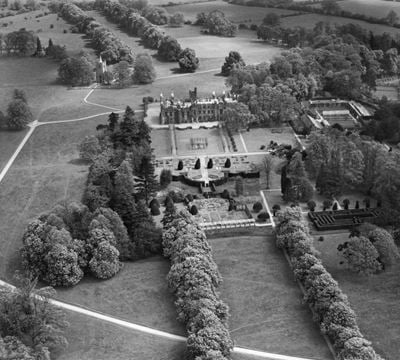
Old Knebworth
Knebworth House and gardens and St Mary's Church, Old Knebworth, 1935
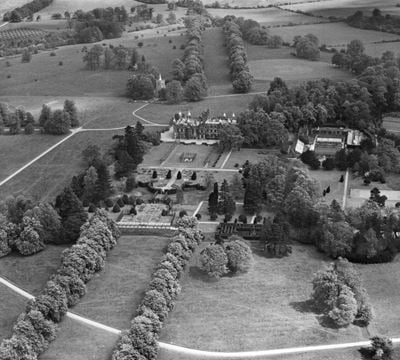
Old Knebworth
Knebworth House and gardens, Old Knebworth, 1935
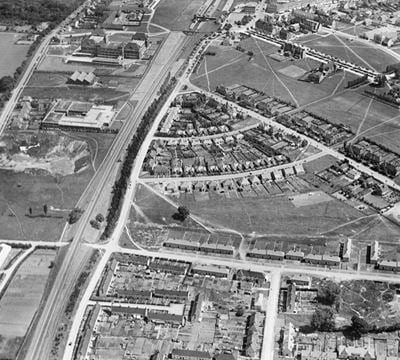
Letchworth Garden City
The Dale and surrounds, Letchworth Garden City, 1925

Letchworth Garden City
Sigma Instruments Co Ltd Factory, Letchworth Garden City, 1953
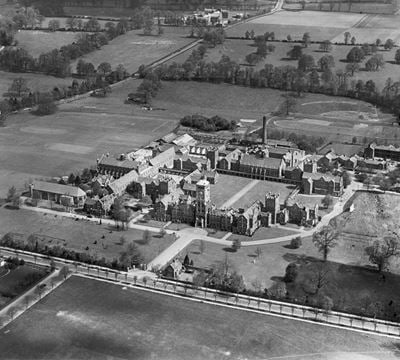
Bushey
The Royal Masonic School for Boys, Bushey, 1931
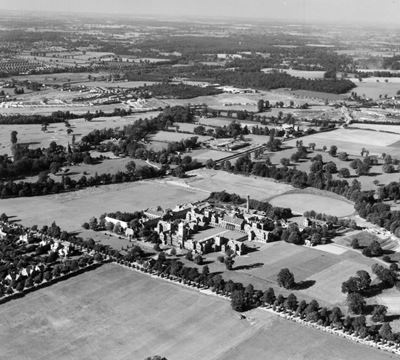
Bushey
The Royal Masonic School and environs, Bushey, 1948
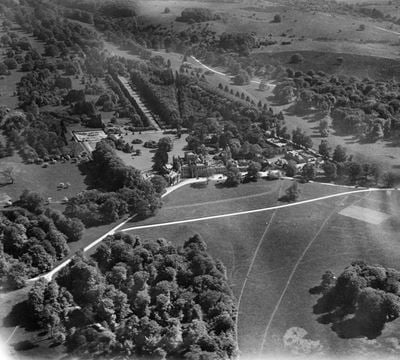
Little Gaddesden
Ashridge House and Park, Little Gaddesden, 1928
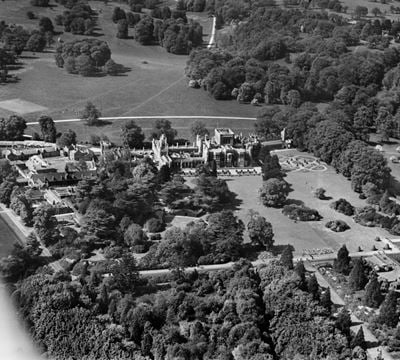
Little Gaddesden
Ashridge House and Park, Little Gaddesden, 1928

Wheathampstead
Bride Hall and the surrounding countryside, Wheathampstead, 1950
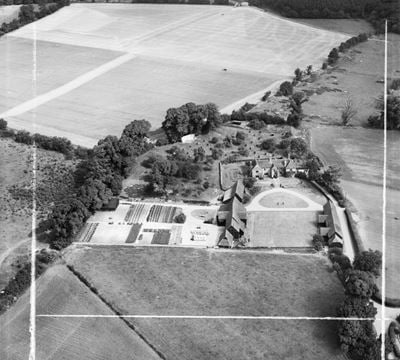
Wheathampstead
Bride Hall, Wheathampstead, 1950
Hertfordshire in the Historic England Archive
The Historic England Archive cares for over 15 million images, dating from the 1850s to the present day. Discover stunning images of Hertfordshire's past. Skip this section and go to stories about heritage
Charles George Harper Collection
Dacorum, Hertfordshire
Date created: 1892 - 1933
Exterior view of King's Langley Priory
Eileen ‘Dusty’ Deste Collection
Great Amwell, East Hertfordshire, Hertfordshire
Date created: circa 1964
A view looking across New River towards a Weeping Willow on the opposite bank with the tower of St John the Baptist's Church in the background
Eric de Mare
Abbots Langley, Three Rivers, Hertfordshire
Date created: 1945 - 1980
Detail view of the Lord Raymond monument in St lawrence's Church in Abbots Langley showing the sculpture of an allegorical female figure with a bust...
John Gay Collection: Highgate and Hampstead
East Hertfordshire, Hertfordshire
Date created: 1973
Looking towards a junction on a village street, probably in East Hertfordshire, the surrounding buildings have rendered walls and plain tile roofs and...
John Gay Collection: Modern Architects
Watford, Hertfordshire
Date created: 1970 - 1979
The steps leading to the Clarendon Road entrance to St Martin's House, a late 20th century office building in Watford
John Gay Collection: Rural Life
Welwyn Hatfield, Hertfordshire
Date created: 1960
A tractor forms the focus of the Harvest Festival display in St Etheldreda's Church
John Gay Collection: Miscellaneous
Moor Park, Rickmansworth, Three Rivers, Hertfordshire
Date created: 1955 - 1965
View from an elevated position, looking past a tree branch to a rural road near Moor Park, with an Austin van parked in front of a thatched cottage
John Gay Collection: Counties
Dacorum, Hertfordshire
Date created: 1966
Harvesting cereal crops in Flaunden using a Claas combine harvester
John Laing Collection
Maple Cross, Rickmansworth, Three Rivers, Hertfordshire
Date created: 01 Jun 1984
View of a concrete paving train at work during the construction of the M25 at Maple Cross
London, Midland and Scottish Railway Company
St. Albans, Hertfordshire
Date created: 27 May 1892
The ruins of the 16th century Sopwell House (also known as Lee Hall) viewed from the south-east
Alfred Newton and Sons
St. Albans, Hertfordshire
Date created: 1896 - 1920
PHOTOGRAPHIC COPY OF BRASS OF THOMAS DELAMERT TAKEN FROM PLATE IN THE BUILDER PUBLICATION
Nigel Temple Collection of Postcards of Parks and Gardens
Watford Heath, Watford, Watford, Hertfordshire
Date created: 1900 - 1920
GENERAL VIEW LOOKING TOWARDS THE HOUSE
Stories about heritage in your local area
Historic England publishes news, blogs, research, videos, and podcasts celebrating England's rich heritage. Discover the stories we have about Hertfordshire. Skip this section and go to education
Grant to Rescue Historic Thundridge Church in Hertfordshire
Mentions Remains of Old Church of St Mary and All Saints, Hertfordshire
Historic England has awarded £72,533 in grant funding for essential works to the Old Church of St Mary and All Saints in Thundridge, Hertfordshire.
What Happened After the End of Roman Rule in Britain?
Mentions Verulamium, site of
After the fall of the Roman Empire in Britain around AD 410, many towns declined, industries ceased, and the Roman army left England's shores.
What Is the Oldest Castle in England?
Mentions Berkhamsted motte and bailey castle
Discover the oldest English castle contenders, including the Norman Berkhamsted Castle, Windsor Castle, Dover Castle and The White Tower, London.
12 Places Connected to Queen Elizabeth I
Mentions Hatfield House
Discover the locations where Queen Elizabeth I lived and visited, including Hampton Court Palace, Hatfield House and Kenilworth Castle.
The Rise and Fall of Anne Boleyn in 12 Historic Places
Mentions Hatfield House
Discover the locations where Anne Boleyn lived, including Hever Castle, the Tower of London, and Hampton Court Palace.
The Timeless Charm of English Market Towns and Halls
Mentions Abbey Church of St Alban
Discover the history of English market towns and halls, including farmers' markets, Christmas markets, market squares and corn exchanges.
An Introduction to Artist Henry Moore
Mentions Hoglands, Family Group Sculpture at Barclay School
From Yorkshire miner’s son to world-famous artist who revolutionised sculpture in the 20th century.
5 Listed Pub Signs in England
Mentions The Fox and Hounds Public House With Inn Sign
Take a look at these historic calling cards for pubs and inns across England.
What Is the Oldest Pub or Inn in England?
Mentions The Fighting Cocks Public House
Many pubs and inns claim to be the oldest pub in England. Here are the facts.
A Brief History of Community Centres in England
Mentions Mrs Howard Memorial Hall
Community centres emerged in the late 19th century through a variety of social movements.
A Brief History of Gurdwaras in England
Mentions Sikh Community Centre
There are thought to be over 200 gurdwaras across the UK.
Women Architects Who Helped Shape England
Mentions Sugden House, 2 Farm Field, 102, Orchard Road, The Burleigh Primary School
Women have always influenced domestic design but it wasn’t until 1898 that the first female architect was admitted to the Royal Institute of British...
An Introduction to Quaker Meeting Houses
Mentions Hertford Quaker Meeting House
The earliest Quaker meeting houses were distinctive for their simple, functional design; built by local craftsmen, they sit modestly in the landscape.
Mentions Hertfordshire
Our 'Brutal and Beautiful' exhibition takes its name from the term 'New Brutalism', a style coined by English architects Alison and Peter Smithson in...
What is Brutalism? | Brutal & Beautiful: Part 1
Our 'Brutal and Beautiful' exhibition takes its name from the term 'New Brutalism', a style coined by English architects Alison and Peter Smithson in 1953.
Grant to Rescue Historic Thundridge Church in Hertfordshire
Mentions Remains of Old Church of St Mary and All Saints, Hertfordshire
Historic England has awarded £72,533 in grant funding for essential works to the Old Church of St Mary and All Saints in Thundridge, Hertfordshire.
Research Reports Roundup February 2025
Mentions Hertfordshire
A roundup of the latest additions to our research reports database from October 2024 to February 2025, arranged by theme.
50 Years of Flying for Heritage
Mentions Hertfordshire
Learn about discoveries made in over 50 years of flying by Historic England aerial photographers and their predecessors.
War Memorials Listed in the East of England
Mentions Northchurch War Memorial and former plinth 5m to south-west, Hertford Heath War Memorial, Hertfordshire
4 First World War memorials in Cambridgeshire and Hertfordshire have been listed at Grade II by DCMS on the advice of Historic England.
Southend-on-Sea Civic Fountain Listed
Mentions Mural located in former Lee Valley Water Company Offices and free-standing sculpture on west side of entrance drive
The Civic Fountain in Southend-on-Sea, Essex, has been listed at Grade II by DCMS on the advice of Historic England.
16 Remarkable Historic Places Listed in 2023
Mentions Barkway Carriage Wash also known as the Wagon Wash, Hertfordshire
Take a closer look at the historic gems that were examined, protected and added to the National Heritage List for England in 2023.
7 War Memorial Listed In The East of England Ahead of Remembrance Weekend
Mentions Goffs Oak War Memorial, Hertfordshire
Memorials in Cambridgeshire, Hertfordshire, Essex and Bedfordshire have been listed at Grade II by DCMS on the advice of Historic England.
Heritage at Risk in the East of England Revealed
Mentions Minsden Chapel at North East Corner of Minsden Plantation Grid Reference TL 1982 2458, Hertfordshire
9 sites have been saved and 31 sites added to the Heritage at Risk Register 2023 in the East of England.
Rare Phone Boxes Listed on the London Underground
Mentions K8 Kiosk at Chorleywood Station
Four rare K8 phone boxes on the London Underground network have been listed at Grade II.
Historic England Highlights Fascinating Heritage Sites Listed in 2022
Mentions The Cottage and former Soup Kitchen, Berkhamsted Castle, Hertfordshire
As 2022 draws to a close, Historic England highlights gems added to the National Heritage List for England (NHLE) over the last 12 months.
Exploring the Experiences of Disabled Heritage Professionals
Mentions Hertfordshire
Exploring the experiences of disabled people working in the heritage sector.
Public Artworks Protected With New Listings
Mentions Tiled mural by Gyula Bajó at former Co-operative House, 'Scenes of Contemporary Life' by William Mitchell, Hertfordshire
A tiled mural by Gyula Bajó and two murals by innovative sculptor William Mitchell in Stevenage and Birmingham have been listed at Grade II.
Hertfordshire's social history through photos
Over 10,000 images from the Historic England Archive have been specially selected and re-captioned for teachers, students, and anyone who wants to learn more about their local area. Skip this section and go to grant-aided places
Young girl kneeling on roadside
Period: 1950s (1950 - 1959)
Portrait of a girl holding a bunch of cowslips, kneeling on a roadside in East Hertfordshire
Young girl kneeling on roadside
Young boy playing with dog
Period: 1960s (1960 - 1969)
An informal portrait of a young boy with a dog, taken in Hertfordshire.
Young boy playing with dog
Wynne's Almshouses, High Street, Baldock, Hertfordshire
Period: Stuart (1603 - 1713)
These almshouses are dated 1621. In 1614 John Wynne, a cloth merchant from London left £1000 in his will.
Wynne's Almshouses, High Street, Baldock, Hertfordshire
Tags
Wrotham Park, Dancers Hill Road, Potters Bar, Hertfordshire
Period: Victorian (1837 - 1901)
This is the entrance to Wrotham Park. The landscaped park and pleasure grounds to Wrotham Park House cover an area of 116 hectares.
Wrotham Park, Dancers Hill Road, Potters Bar, Hertfordshire
Widford School, Ware Road, Widford, Hertfordshire
Period: Victorian (1837 - 1901)
This school was built in 1875-6. After the 1870 Education Act the small school from 1829 was considered to be "altogether unsuitable".
Widford School, Ware Road, Widford, Hertfordshire
Welwyn Railway Viaduct, Bessemer Road, Welwyn Garden City, Hertfordshire
Period: Victorian (1837 - 1901)
This railway viaduct was built for the Great Northern Railway. It was built in 1848-50 by Sir William Cubitt and Joseph Cubitt. It has 40 arches.
Welwyn Railway Viaduct, Bessemer Road, Welwyn Garden City, Hertfordshire
Waytemore Castle, The Causeway, Bishops Stortford, Hertfordshire
Period: Medieval (Middle Ages) (1066 - 1484)
These are the remains of a late 11th century motte and bailey castle. It is north of the town on the east bank of the River Stort.
Waytemore Castle, The Causeway, Bishops Stortford, Hertfordshire
Watford General Hospital, Vicarage Road, Watford, Hertfordshire
Period: Victorian (1837 - 1901)
This building is part of Watford General Hospital. The hospital was originally Watford Union Workhouse.
Watford General Hospital, Vicarage Road, Watford, Hertfordshire
Visit grant-aided places near you
These places and buildings have been helped by Historic England's financial grants. Find historic places in your neighbourhood that you never knew existed! Please note that opening times may vary. Skip this section and go to related locations
Watchman's Tower, Knebworth House
Knebworth House, listed at Grade II*, originated in the 16th century but is renowned for its extraordinary Gothic-style remodeling and embellishments...
Ashwell Village Museum, Swan Street
Ashwell Museum, at the heart of an ancient settlement, preserves two bays of a medieval house dating to around 1500.
Watchman's Tower, Knebworth House
Set in 250 acres of Hertfordshire countryside with 28 acres of Formal gardens, Knebworth House has been home to the Lytton family for over 19...
Discover more
Ready for more local heritage? Take a look at these other places nearby


